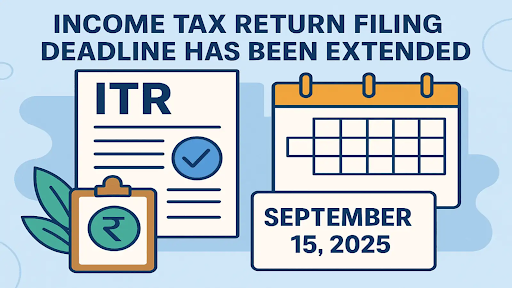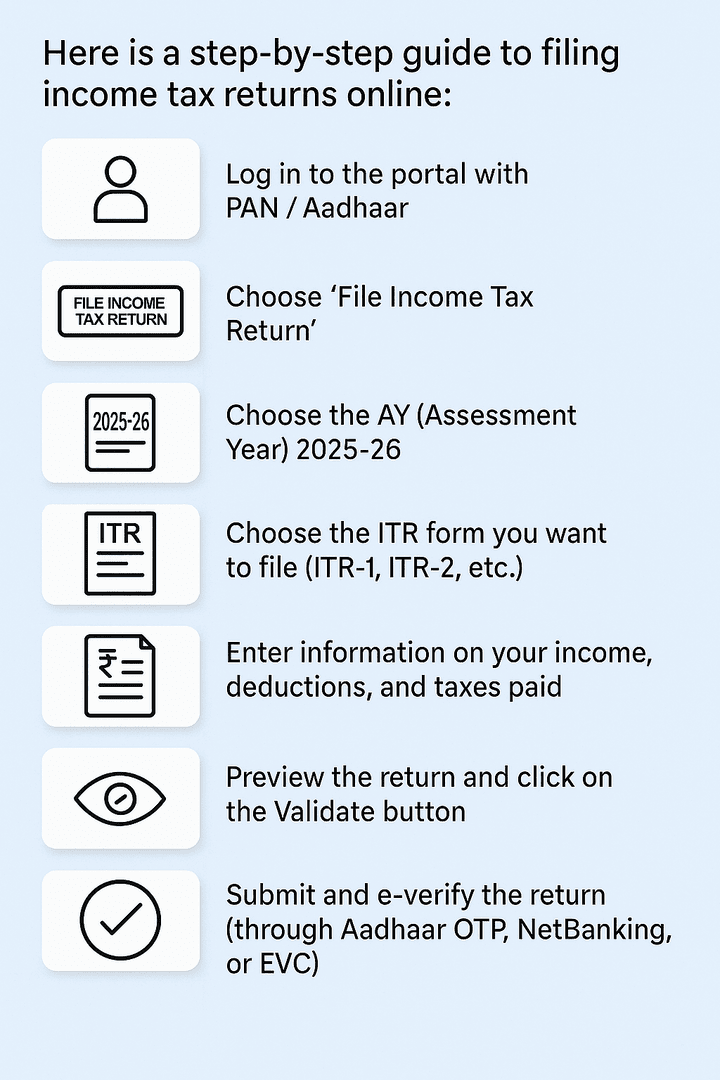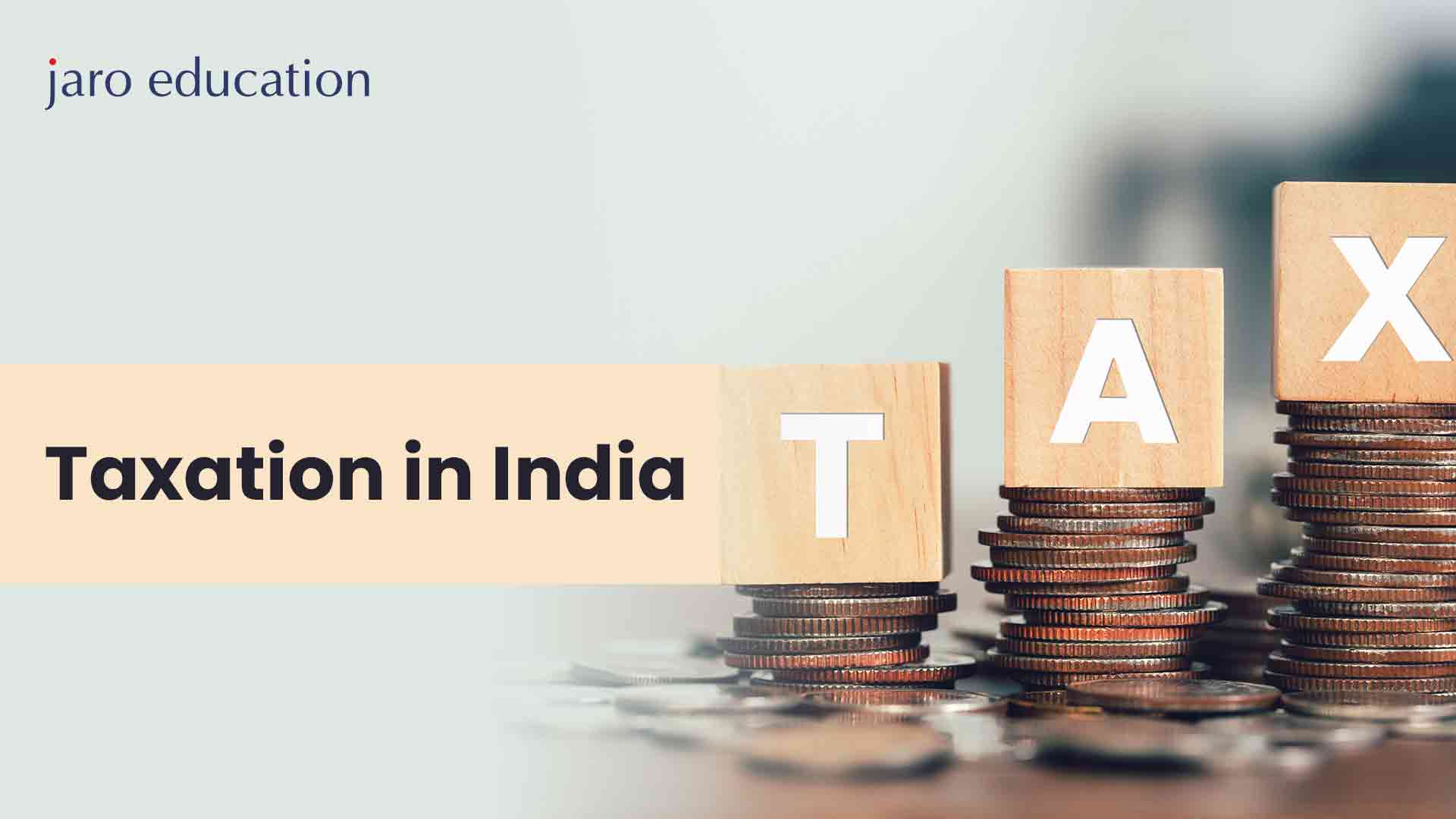Last Date to File ITR for AY 2025–26: Everything You Need to Know
Table of Contents

Are you ready to file your income tax returns (ITRs) for this year? Filing Income Tax Returns for AY 2025-26 is a financial responsibility for any salaried individual, any businessman, or freelancer in India.
This blog provides a comprehensive and easy-to-understand overview of the last date for filing ITR, the ITR filing online process, deadlines, and recent updates.
Let’s get started!
Tax Slabs for AY 2025-26
The Finance Act of 2024 changed the provisions of Section 115BAC from AY 2024-25 onwards, whereby the new tax regime becomes applicable by default for the assessee who is an Individual, HUF, AOP (not being a cooperative society), BOI, or Artificial Juridical Person. However, such eligible taxpayers have the right to choose not to come under the new tax regime and instead continue to be taxed under the old tax regime. By old tax regime, it is meant other than the new system of income tax, ITR filing last date calculation, and slabs. Under the old regime, taxpayers were able to claim several deductions and exemptions. In the case of ‘non-business cases’, the option to select the regime is available every financial year in the ITR to be filed on or before the due date as per section 139(1). For taxpayers with income from business and profession, the new tax regime is automatically applicable unless elected otherwise. If the taxpayer wants to come out of the new tax system, then he/she has to submit Form-10-IEA and this has to be done before the deadline under section 139(1) for filing the return of income.
Income tax ITR filing online for individuals (resident- or non-resident) less than 60 years of age anytime during the previous year is as under:
Old Tax Regime | New Tax Regime u/s 115BAC | ||||
Income Tax Slab | Income Tax Rate | *Surcharge | Income Tax Slab | Income Tax Rate | *Surcharge |
Up to ₹ 2,50,000 | Nil | Nil | Up to ₹ 3,00,000 |
Nil | Nil |
₹ 2,50,001 – ₹ 5,00,000** | 5% above ₹ 2,50,000 | Nil | ₹ 3,00,001 – ₹ 7,00,000** | 5% above ₹ 3,00,000 | Nil |
₹ 5,00,001 – ₹ 10,00,000 | ₹ 12,500 + 20% above ₹ 5,00,000 | Nil | ₹ 7,00,001 – ₹ 10,00,000 | ₹ 20,000 + 10% above ₹ 7,00,000 | Nil |
₹ 10,00,001- ₹ 50,00,000 | ₹ 1,12,500 + 30% above ₹ 10,00,000 | Nil | ₹ 10,00,001 – ₹ 12,00,000 | ₹ 50,000 + 15% above ₹ 10,00,000 | Nil |
₹ 50,00,001- ₹ 100,00,000 | ₹ 1,12,500 + 30% above ₹ 10,00,000 | 10% | ₹ 12,00,001 – ₹ 15,00,000 | ₹ 80,000 + 20% above ₹ 12,00,000 | Nil |
₹ 100,00,001- ₹ 200,00,000 | ₹ 1,12,500 + 30% above ₹ 10,00,000 | 15% | ₹ 15,00,001- ₹ 50,00,000 | ₹ 1,40,000 + 30% above ₹ 15,00,000 | 10% |
₹ 200,00,001- ₹ 500,00,000 | ₹ 1,12,500 + 30% above ₹ 10,00,000 | 25% | ₹ 50,00,001- ₹ 100,00,000 | ₹ 1,40,000 + 30% above ₹ 15,00,000 | 15% |
Above ₹ 500,00,000 | ₹ 1,12,500 + 30% above ₹ 10,00,000 | 37% | ₹ 100,00,001- ₹ 200,00,000 | ₹ 1,40,000 + 30% above ₹ 15,00,000 | 25% |
Income ITR filing last date for individuals (resident or non-resident), 60 years or more but less than 80 years of age, anytime during the previous year, is as under:
Old Tax Regime | New Tax Regime u/s 115BAC | ||||
Income Tax Slab | Income Tax Rate | *Surcharge | Income Tax Slab | Income Tax Rate | *Surcharge |
Up to ₹ 3,00,000 | Nil | Nil | Up to ₹ 3,00,000 | Nil | Nil |
₹ 3,00,001 – ₹ 5,00,000** | 5% above ₹ 3,00,000 | Nil | ₹ 3,00,001 – ₹ 7,00,000** | 5% above ₹ 3,00,000 | Nil |
₹ 5,00,001 – ₹ 10,00,000 | ₹ 10,000 + 20% above ₹ 5,00,000 | Nil | ₹ 7,00,001 – ₹ 10,00,000 | ₹ 20,000 + 10% above ₹ 7,00,000 | Nil |
₹ 10,00,001- ₹ 50,00,000 | ₹ 1,10,000 + 30% above ₹ 10,00,000 | Nil | ₹ 10,00,001 – ₹ 12,00,000 | ₹ 50,000 + 15% above ₹ 10,00,000 | Nil |
₹ 50,00,001- ₹ 100,00,000 | ₹ 1,10,000 + 30% above ₹ 10,00,000 | 10% | ₹ 12,00,001 – ₹ 15,00,000 | ₹ 80,000 + 20% above ₹ 12,00,000 | Nil |
₹ 100,00,001- ₹ 200,00,000 | ₹ 1,10,000 + 30% above ₹ 10,00,000 | 15% | ₹ 15,00,001- ₹ 50,00,000 | ₹ 1,40,000 + 30% above ₹ 15,00,000 | 10% |
₹ 200,00,001- ₹ 500,00,000 | ₹ 1,10,000 + 30% above ₹ 10,00,000 | 25% | ₹ 50,00,001- ₹ 100,00,000 | ₹ 1,40,000 + 30% above ₹ 15,00,000 | 15% |
Above ₹ 500,00,000 | ₹ 1,10,000 + 30% above ₹ 10,00,000 | 37% | ₹ 100,00,001- ₹ 200,00,000 | ₹ 1,40,000 + 30% above ₹ 15,00,000 | 25% |
Last Date to File ITR AY 2025-26

*The Economics Times
Now, let’s go over every taxpayer’s biggest worry: “What’s the last date to file an ITR filing start date for AY 2025-26?”
Well, unfortunately, there is good news: the Income Tax Department has already assigned different due dates for various categories of taxpayers. Believe me, if you just note down these dates, you stand a chance of bypassing penalties and the bunch of stress!
Whether you are a salaried employee, a businessman, or through a company, your due date for filing returns is.
Have a look at this simple table:
Taxpayer Category | Last Date to File ITR (AY 2025-26 | Remarks |
Individual (Salaried, Freelancers, Pensioners) | 31st July 2025 | For those not requiring an audit |
Businesses/Professionals requiring an audit | 31st October 2025 | The audit report must be filed before this |
Companies (requiring an audit) | 31st October 2025 | The audit report must be filed before this |
Taxpayers under the Transfer Pricing Regulations | 30th October 2025 | Includes international transactions |
Belated or Revised ITR | 31st October 2025 | With a late fee (if the original deadline was missed) |
Income Tax ITR Filing Online: Who Needs to File?
So, who needs to file an Income Tax Return (ITR) in India? Great question — and one that many people still get confused about.
Let’s break it down.
If you fall into any of the following categories, you must file your ITR online for the Assessment Year 2025-26:
| Condition | Do You Need to File ITR? |
|---|---|
| Your total income exceeds ₹2.5 lakh (before deductions) | Yes |
| You're a senior citizen (60+) earning over ₹3 lakh/year | Yes |
| You're a super senior citizen (80+) earning over ₹5 lakh/year | Yes |
| You're a company, LLP, or partnership firm — even with zero profit | Yes |
| You want to claim a tax refund | Yes |
| You earn from freelancing, business, or gig work | Yes |
| You had foreign assets or income | Yes |
| You deposited over ₹1 crore in a savings/current bank account | Yes |
| You spent over ₹2 lakh on foreign travel in a year | Yes |
| You paid ₹1 lakh+ in electricity bills in a year | Yes |
But what happens if my income is below the limit?
Though you may not be obligated to file ITR, at least you can benefit greatly if you do:
- You can get a refund if excess TDS (Deducted at Source) has been deducted by the bank or your employer
- Provides proof of income with which you can take out loans, visas, or government schemes
- You can carry forward losses (capital loss, for example) and offset gains in the future
Real-Life Example
Let’s say you are a student, working freelance, earning ₹2.6 lakh last year. You are above the basic exemption limit and must, therefore, file IT returns.
For another case, a clerical employee earning ₹2.3 lakh is supposedly not needed to file income tax returns, but doing so will at least incur a fine for claiming refunds or showing income.
ITR Filing Online: A Step-by-Step Guide
The government has simplified income tax return filing online through the Income Tax e-Filing Portal.
Here is a step-by-step guide to filing income tax returns online:
- Log in to the portal with PAN/Aadhaar.
- Choose ‘File Income Tax Return’.
- Choose the AY (Assessment Year) 2025-26.
- Choose the ITR form you want to file (ITR-1, ITR-2, etc.)
- Enter information on your income, deductions, and taxes paid.
- Preview the return and click on the Validate button.
- Submit and e-verify the return (through Aadhaar OTP, NetBanking, or EVC).

Pro Tip: If you are a salaried individual, you may prefill some data from Form 16 and AIS data so as to avoid any inadvertent errors.
Summary:
| Key Area | Details |
|---|---|
| Last Date to File ITR | 31st July 2025 (Individuals) |
| Start Date to File ITR | 1st April 2025 |
| Belated Return Deadline | 31st December 2025 |
| Filing Mode | Online via incometax.gov.in |
| Documents Required | PAN, Aadhaar, Form 16, 26AS, AIS |
| Penalty for Late Filing | ₹1,000–₹5,000 |
Conclusion
Filing your ITR can be a tedious task; however, it is crucial in maintaining financial responsibility. While for most individuals the deadline is 31st July 2025, it is prudent not to wait till the last moment.
From knowing which group of taxpayers falls under filing an ITR, to keeping abreast with the recent developments, selecting the appropriate ITR form, and even managing the ITR refund
Frequently Asked Questions
What is the last date to file ITR for AY 2025–26?
For individuals not requiring an audit, the last date is 31st July 2025. For businesses requiring an audit, it’s 31st October 2025. Belated returns can be filed till 31st December 2025.
Who is required to file ITR?
Anyone whose gross total income (before deductions) exceeds the basic exemption limit (₹2.5 lakh for individuals under 60) must file an ITR. Also, people with foreign income, TDS deductions, businesses, or those claiming a refund need to file.
Can I file my ITR online?
Yes, absolutely! You can file it via the Income Tax e-Filing Portal using ITR utilities or third-party services. Salaried individuals can often complete the process in under 30 minutes.
What happens if I miss the ITR filing deadline?
If you miss the deadline, you can still file a belated return until 31st December 2025, but you may have to pay a late filing fee of up to ₹5,000 and lose out on some benefits like carrying forward losses.
How do I know which ITR form to use?
It depends on your income source:
- ITR-1: Salary, pension, interest income (up to ₹50L)
- ITR-2: Capital gains, foreign income
- ITR-3: Business/profession
- ITR-4: Presumptive income scheme

















